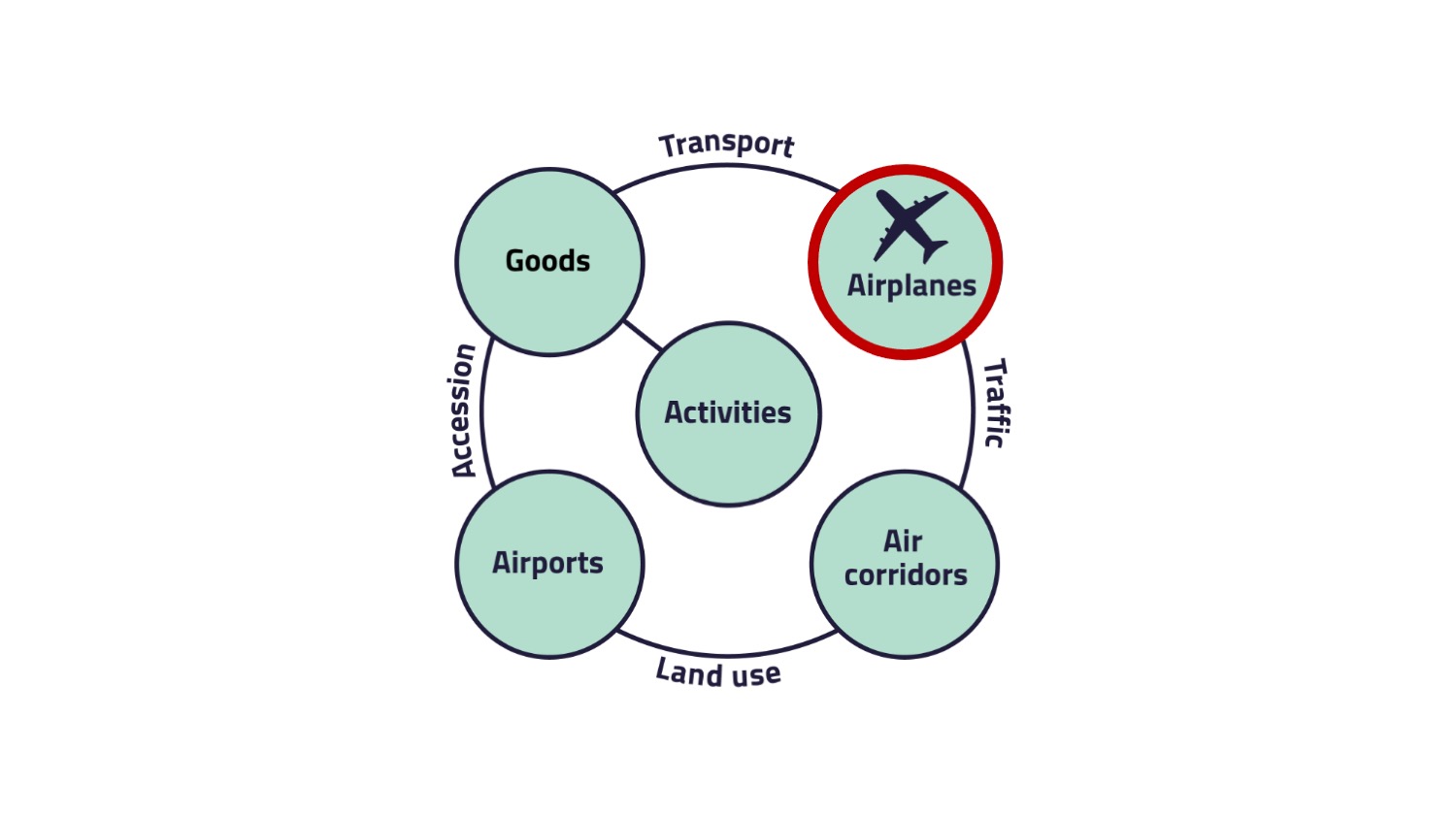Air Transport System
In this section, you will learn more about the air
transport system. The air transport system will
be presented according to the structure of the conceptual system model of transport and traffic.
You will learn more about the goods, being
transported by air, the different kind of airplanes, used air corridors
and airports.
4. Airplanes
On this page, the movables of the air transport system model are presented to you. In terms of air transport, those movables are the "Airplanes".

Different types of aircraft are used for air freight transportation, depending on the quantity of goods to be transported and the transport distance.
The following list shows different kinds of freight airplanes. Some of them will be presented to you in detail below. Airplanes can either transport persons and goods at the same time, or they can be used for cargo transport only.
Overview freight airplanes
Current model series Airbus
Overview freight airplanes
Current model series Airbus
- A320 freighter family
- A350F
- A321P2F
- A330-200F
- A330-P2F
- BelugaST
- BelugaXL
- Boeing 777F
- Boeing 777-8F
- Boeing 747-8F
- Boeing 767-300F
- Boeing 767-300BCF (Boeing Converted Freighter)
- Boeing 737-800BCF
- Boeing MD-11
- Antonow AN-225
While the A319 and the A330 are transporting passengers and freight at the same time, the A321P2F, A330-200P2F, BelugaST, BelugaXL and Boeing 777F are used exclusively for freight transport..
The relation between airplanes and air corridors is called traffic.
Traffic
Air traffic is taking place especially between the USA, Europe and Asia.
The figure "Air traffic flows" shows the intercontinental flows. The size of the arrow is dependent on the traffic volume.
Various traffic management and control systems are used to ensure safe air traffic operations.
Air Traffic Management Systems
Air traffic management (ATM) means the aggregation of the airborne and ground-based functions (air traffic services, airspace management and air traffic flow management) required to ensure the safe and efficient movement of aircraft during all phases of operations.
Air Traffic Management Systems
Air traffic management (ATM) means the aggregation of the airborne and ground-based functions (air traffic services, airspace management and air traffic flow management) required to ensure the safe and efficient movement of aircraft during all phases of operations.
Air traffic control (ATC) service means a service provided for the purpose of:
- preventing collisions: - between aircraft, and - in the maneuvering area between aircraft and obstructions.
- expediting and maintaining an orderly flow of air traffic.
Air Space Management means planning and dividing available airspace with the aim of making the best possible use of it.
Air Traffic Flow Management means planning and controlling the volume of air traffic with the aim of ensuring a safe, orderly and high traffic flow. To this end,
- the maximum utilization of existing capacities must be ensured and
- congestion situations in individual traffic areas must be avoided by regulating traffic.
As presented to you before, the air traffic can be carried out either by passenger and freight airplanes or by only freight airplanes.
Intercontinental flight passage with belly cargo
The share of revenue on an intercontinental flight in the air freight area of an airline can account for up to 20 %. Air cargo thus plays a significant role in the profitability of an intercontinental flight. If there is unpaired traffic (e.g. west-east weakness) in the air freight area, this does not necessarily lead to the discontinuation of the route service. This is quite different in the passenger sector (First, Business and Eco Class). Not all intercontinental connections are the same. A distinction must always be made between hub feeders and non-hub feeders, which have different value and contribution margins for the airlines.
Intercontinental all-cargo flight
The air cargo revenue share on a freighter flight is 100 %. It is therefore a decisive factor in determining the profitability of a freighter flight. If there is unbalanced traffic (west-east weakness) and/or poor yield (rate) in the air cargo sector, this usually leads to the discontinuation of route operations in the long term. Also in the case of a freighter flight, a distinction must be made between hub and non-hub flights, which have different value and contribution margins for the airlines.
Literature
Airbus (2021): A319ceo. URL: https://aircraft.airbus.com/en/aircraft/a320/a319ceo (last access: 30.03.2022).
Airbus (2021): A330-300. URL: https://aircraft.airbus.com/en/aircraft/a330/a330-300 (last access: 30.03.2022).
Airbus (2021): A321P2F. URL: https://aircraft.airbus.com/en/aircraft/freighters/a321p2f (last access: 30.03.2022).
Airbus (2021): A330-200F. URL: https://aircraft.airbus.com/en/aircraft/freighters/a330-200f (last access: 30.03.2022).
Airbus (2021): BelugaST. URL: https://aircraft.airbus.com/en/aircraft/freighters/belugast (last access: 30.03.2022).
Airbus (2021): BelugaXL. URL: https://aircraft.airbus.com/en/aircraft/freighters/belugaxl (last access: 30.03.2022).
EASA (2018): What is the difference between ATM and ATC? URL: https://www.easa.europa.eu/faq/45953 (last access: 30.03.2022).
Flämig, H., Sjöstedt, L., Hertel, C. (2002): Multimodal Transport: An Integrated Element for Last-Mile-Solutions? Proceedings, part 1; International Congress on Freight Transport Automation and Multimodality: Organisational and Technological Innovations. Delft, 23 & 24 May 2002. (modification of Sjöstedt 1996)
Lufthansa Cargo (2021): B777F. URL: https://lufthansa-cargo.com/de-DE/web/guest/fleet-ulds/fleet/b777f (last access: 30.03.2022).